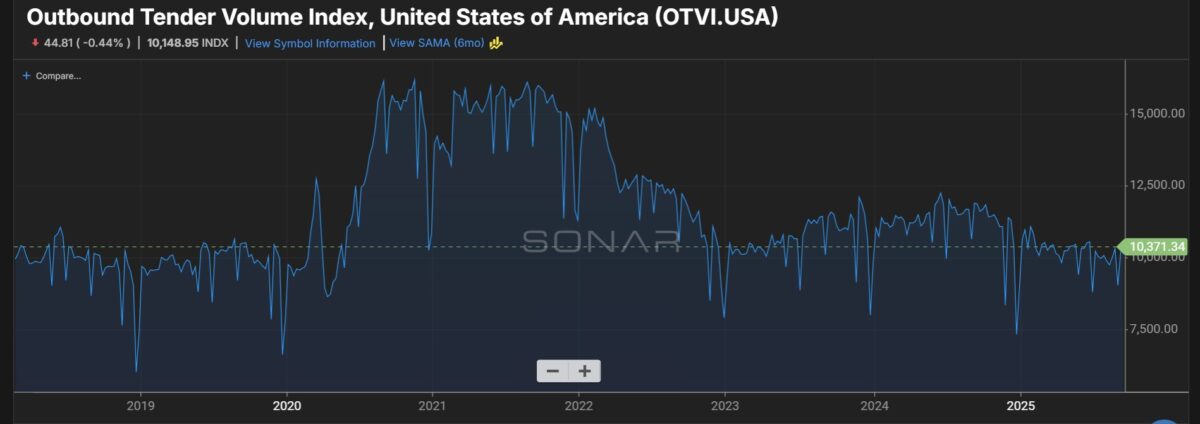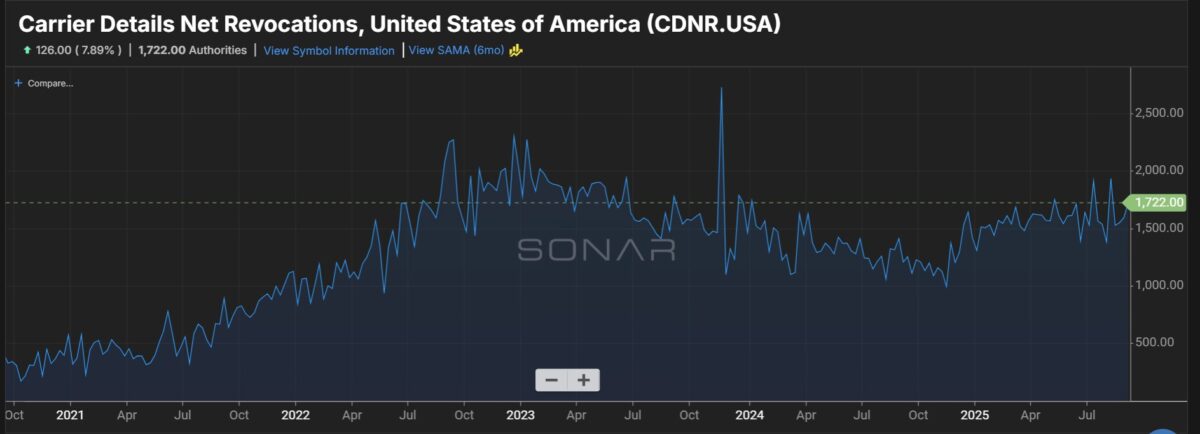Coming a few weeks after an earnings season that saw a lot of trucking companies struggling (or even failing) to turn a profit, and an interim update from LTL carriers that was decidedly weak, the FreightWaves September State of Freight webinar spent much of the time parsing through various data points of a market firmly in year three of a freight recession.
Join the leaders shaping freight’s future at
F3: Future of Freight Festival, Oct 21-22.
Network with the industry’s best and discover what’s next.
But by the end of the one-hour webinar, FreightWaves and SONAR CEO Craig Fuller was able to offer an optimistic outlook. The road to get there still has plenty of hurdles.
Here are five takeaways from this month’s session with Fuller and Zach Strickland, SONAR’s director of freight market intelligence.
Volume data has differences but shows little sign of strength
A discussion about comparing data sets on volume indicators noted that Cass data, which is widely respected, is based on invoices. So there is a lag between it and the data in the Outbound Tender Volume Index in SONAR.
The publication of Cass data a day before the State of Freight webinar was largely negative across the board. Its multimodal transportation index was down 9.3% year-over-year. Volumes in August were down 1.5% from a month earlier. Particularly weak were LTL shipments.
“Being invoice data it means that these invoices come in when the carrier, the provider, bills them,” Fuller said. “And sometimes it can be weeks or months. So you get this lag in Cass’ data.”
The OTVI, being based on real time data, shows that while the freight market measured by volume was “a pretty marginal summer, but it wasn’t a collapse.”
But the bigger picture, Fuller noted, is that the OTVI is now not far from where it was in 2018, which was considered a robust freight market. “The truth is that none of the volume data should ever revert back,” Fuller said. “It’s like having a business where you’re like, oh, we’re doing better than we were seven years ago. How is that something to brag about? You’ve lost seven years of compounded growth.”
Strickland noted that back in 2018, the Outbound Tender Rejection Index in SONAR was 17.5% against a volume that is largely unchanged. It’s now just over 5%.

How is it possible to have a low OTRI against a stable volume of freight?
With so much focus on the push by the federal government to remove non-English speaking and other non-qualified drivers from the road, Strickland and Fuller turned to the issue of capacity.
Strickland noted that despite all the market turmoil, SONAR’s OTRI is still hovering a little more than 5%, and has been for awhile.
It’s been a long road to get to the current level of capacity, Fuller said, citing a process that began in the Obama administration with an impact that continues today. That administration, he said, “loosened up rules” that allowed more drivers on the road, but some of it was encouraged by “trucking interests” who wanted them to allow for labor supply to come into the market. Because the thinking was we have a driver shortage and we need to bring new drivers in.”
That new capacity didn’t all end up at big carriers. To the contrary, their insurers would have halted that kind of hiring, Fuller said. Instead, he added, they went to smaller carriers, “the ones that are truly fighting for survival, and in doing so, it just exacerbated the excess capacity.”

What about the drivers being taken off the road?
The current pace of capacity exits, as recorded by FMCSA data and displayed in the CDNR.USA data series in SONAR, is showing signs that the exodus out of the market is continuing, Strickland said. And Fuller said that is not surprising.
Strickland noted there is a lag in the data. Fuller added that it was June when Secretary of Transportation Sean Duffy made the crackdown on non-English speaking drivers a key goal of the DOT. “That’s why I think you’re starting to see a lot of these regulatory changes are going to have an impact and it’s going to continue to show up in the data,” he said.

Everybody is losing money but many still stick around
Fuller made a startling observation. “For the most part most trucking companies on a per mile basis are losing money.” Then why aren’t the capacity exits occurring quicker?
Part of it is that about 40% of costs are fixed. Even as the miles rack up on a losing basis, cash is being generated, “even as they’re underwater,” Fuller said. “And what’s happened is that this freight recession has gone on so long that a lot of these guys have been losing money or equity, but generated enough cash to stay alive.”
But that can’t go on forever and that may be contributing to the loss in capacity that is showing up in the net revocations, but not yet in the OTRI. After years of those losses, Fuller said, “a lot of the trucks are now five years old.” And it’s getting near time to buy a new truck.
“When they need to go buy a new truck, they can’t,” Fuller said. “They can’t maintain them, and then the trucks start to fall apart. They start to have safety problems. The fleets can’t attract drivers, and they end up in accidents, because when you stop maintaining the truck, it’s going to become less safe.”
That combination, Fuller said, “is why I think capacity is going to continue to come out of the market.”
Hearing some positive news
Before turning to a more optimistic outlook, Fuller said “I truly think the economy, the freight economy is bad, the Main Street economy is bad.” But he said he also has been talking to other executives who are reporting more solid operations than the bad news might indicate.
Fuller mentioned a friend who he said runs a consulting business tied to logistics. “I talked to them yesterday, and he said we’ve never been more busy,” Fuller said, with a strong amount of business tied to M&A activity in the sector.
“There are companies willing to make investments in the business,” Fuller said. That doesn’t mean there’s going to be some quick turnaround, he added. “It’s not like we’re out of the (freight) recession. I want to be clear. I’m not saying we’re done.”
But he said those business executives he is speaking with “are starting to see signs of strength in their business. They’re starting to see things that feel a little bit better.”
More articles by John Kingston
Werner faces social media storm over Kenyan driver rumors
TQL opponent in broker liability SCOTUS case: let it ‘percolate’
TIA warns: TQL-linked broker liability case threatens industry
The post State of Freight takeaways: volumes are weak to stable but silver linings on the horizon appeared first on FreightWaves.


















